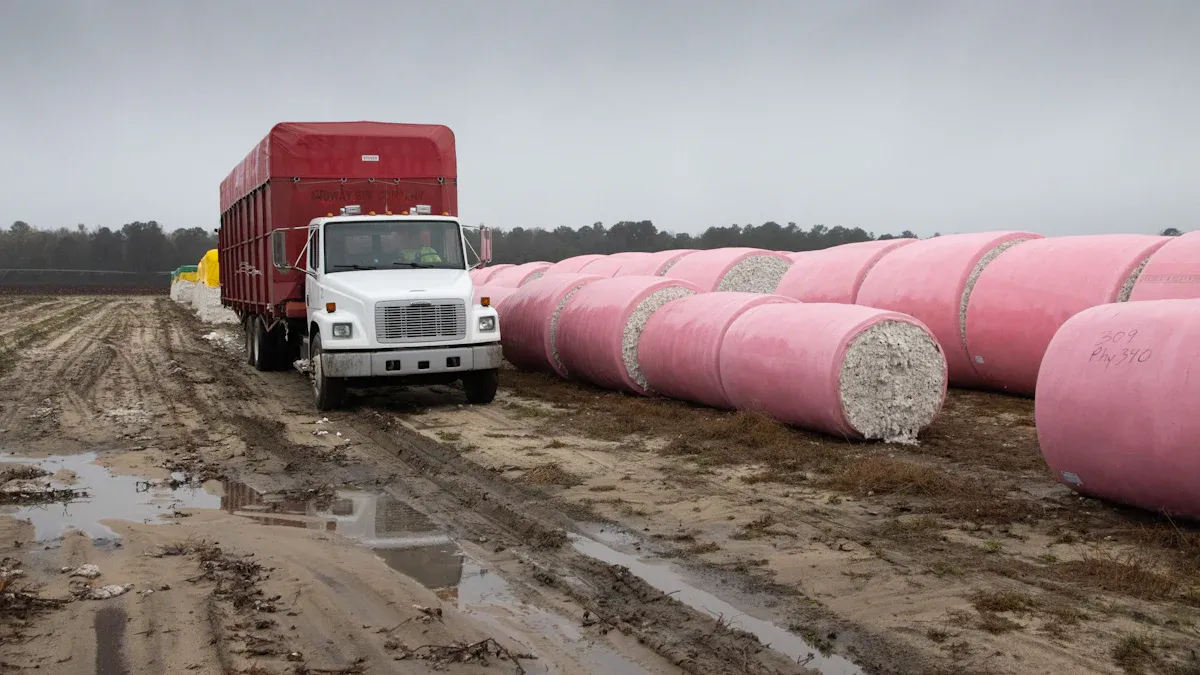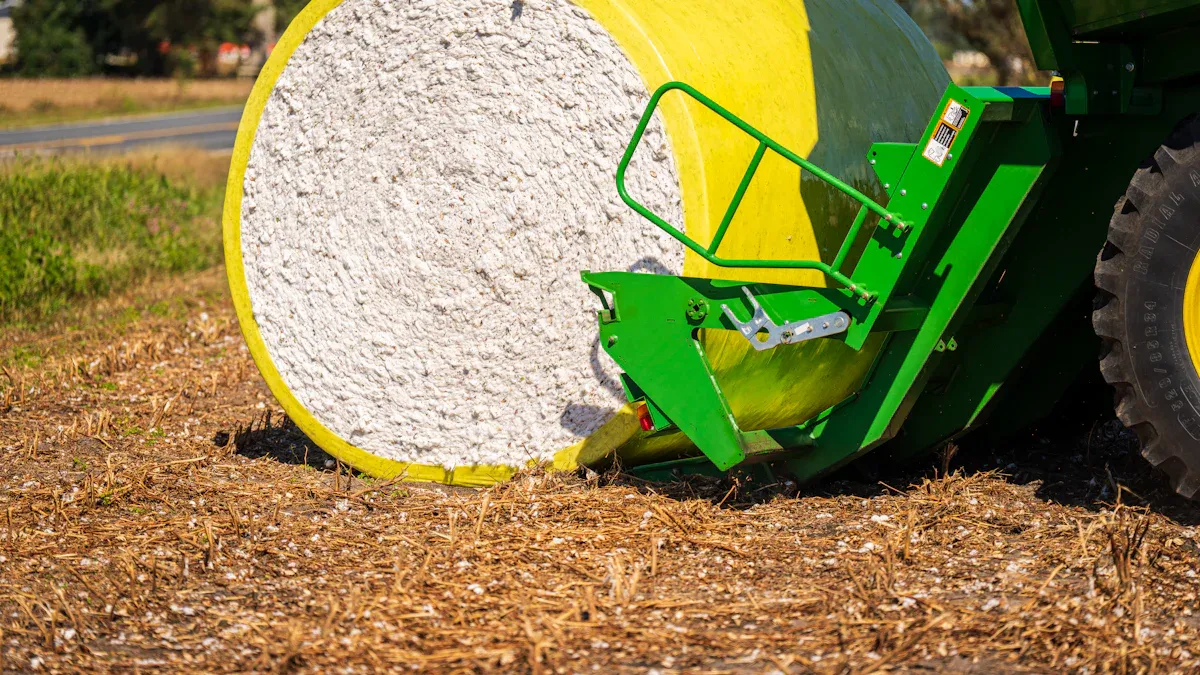Cotton is a highly sensitive commodity that can be easily affected by moisture, dust, and mechanical damage during transport and storage. Proper bale packaging ensures the fiber maintains its quality from the field to the processing facility, safeguarding both commercial value and operational efficiency.
Color coding is an established method in the cotton sector to facilitate the identification of different bales. By assigning specific colors, cotton grades, sources, and handling requirements can be instantly differentiated.
Standard Color Codes in Cotton Industry
Yellow
Yellow bale wrap color stands out in the cotton industry. It signals premium quality, as seen in tama cotton wraps like Tamarap Plus Premium. The yellow color also improves visibility, making cotton bales easier to spot during transport and storage.
This visibility helps prevent accidents and supports safety in busy environments. Yellow cotton bale wraps help maintain cotton quality by reducing contamination.
Green
Green wraps indicate a focus on sustainability. Producers use green wraps to show that their cotton comes from eco-friendly practices. These wraps often mean the cotton is organic and grown with fewer chemicals. Green wraps help buyers identify cotton that supports environmental responsibility.
Blue
Blue wraps are less common but serve practical purposes. They can help distinguish cotton from different regions or farms. Blue wraps may also help with sorting during processing. Some producers use blue to create a unique identity for their cotton bales.
Pink
Pink wraps carry both symbolic and practical value. Many farms use pink wraps to support breast cancer awareness pink wrap campaigns. Pink wraps show solidarity and raise awareness for this important health issue. They also offer strong protection against weather and handling. The chart below shows how the public connects pink wraps with breast cancer awareness.
Purple
Purple wraps are rare in the cotton industry. Some producers use purple for special identification or branding. Purple may also help with sorting or tracking cotton bales during storage.
Purpose of Using Different Colors for Cotton Bales
Identifying Cotton Grades
Different colors on cotton bale wrap help workers and buyers quickly identify cotton grades. This system reduces confusion and speeds up sorting in large warehouses.
Color coding also supports quality control. Workers can spot high-quality or specialty cotton bales at a glance. This process helps prevent mixing of grades and maintains product standards.
Distinguishing Cotton Sources
Colored wraps make it easy to trace cotton back to its source. Farms and regions often use specific colors to mark their cotton bales. This practice helps buyers and processors track the origin of each bale.
- Different colored cotton fibers can be distinguished based on their sources through the examination of seeds and fiber characteristics.
- The fiber from green cotton beds was either green or light brown, while the brown beds produced brown or light brown fibers, indicating genetic variations.
- The texture of the fibers also varied, with green cotton having a more silky feel compared to the brown cotton, which aids in identifying their origins.
This color system supports traceability and transparency in the supply chain. It also helps prevent mix-ups between bales from different farms or regions.
Facilitating Efficient Storage and Logistics
Color-coded wraps improve storage and logistics in cotton warehouses. Workers use colored wraps to organize bales by type, grade, or source. This system reduces errors and saves time during loading and unloading.
Note: Functional printing on colored canvas allows for direct handling instructions and identification codes, reducing the need for extra labels.
Color also plays a symbolic role. Some farms choose colors to support charity or create a unique look. Colors evoke emotions and convey meanings, which can influence how people feel about cotton bales. Consistent use of color in branding helps create recognition and preference in the market.
Benefits of Color-Coded Cotton Bales
Simplified Sorting and Processing
Color-coded bale wrap helps workers sort and process cotton bales quickly. Each net wrap color stands for a specific grade or source. This system allows workers to identify the right bales without opening them.
- Enhanced visibility makes it easier to spot the correct bales.
- Improved inventory tracking helps keep records accurate.
- Reduced errors in handling and processing save time and resources.
When workers see a certain net wrap color, they know exactly where the bale belongs. This method keeps the sorting process smooth and efficient.
Minimizing Errors in Supply Chain
Using different bale wrap colors reduces mistakes during shipping and storage. Workers can match bales to the correct trucks or storage areas by color. This practice lowers the risk of mixing up orders or sending the wrong cotton to customers.
Note: Clear color codes help prevent costly errors and delays in the supply chain.
Companies rely on color-coded wraps to keep their operations running smoothly. They can spot problems early and fix them before they grow.
Enhancing Traceability for Quality Control
Color-coded wraps make it easier to trace cotton back to its source. Each net wrap color links to a specific farm or region. This traceability supports quality control and helps companies meet industry standards.
If a problem appears, workers can track the affected cotton bales by their wrap color. This process protects the reputation of producers and ensures better protection for the product. Color coding also helps buyers trust the quality and origin of the cotton they receive.
Conclusion
Cotton bale color coding serves as a practical tool for identifying grade, origin, and handling requirements. It protects fiber quality, streamlines logistics, and facilitates efficient processing.
For cotton traders and manufacturers, adopting standardized color coding, supported by digital tracking solutions, ensures operational efficiency, supply chain transparency, and reliable quality control.
Protect Your Cotton with AgriShade Colored Wraps
Protect your cotton with AgriShade’s durable, colored cotton bale wraps. Available in multiple colors, our wraps allow efficient organization, tracing, and handling of cotton. They safeguard fibers from moisture, dust, and damage.
Ready for fast delivery, our wraps enable you to secure your cotton promptly. Choose the color that meets your needs and ensure reliable protection for every bale. With AgriShade, obtain professional-grade wraps that support organized handling and clear identification. Contact us today to place your order for color-coded wraps.



















